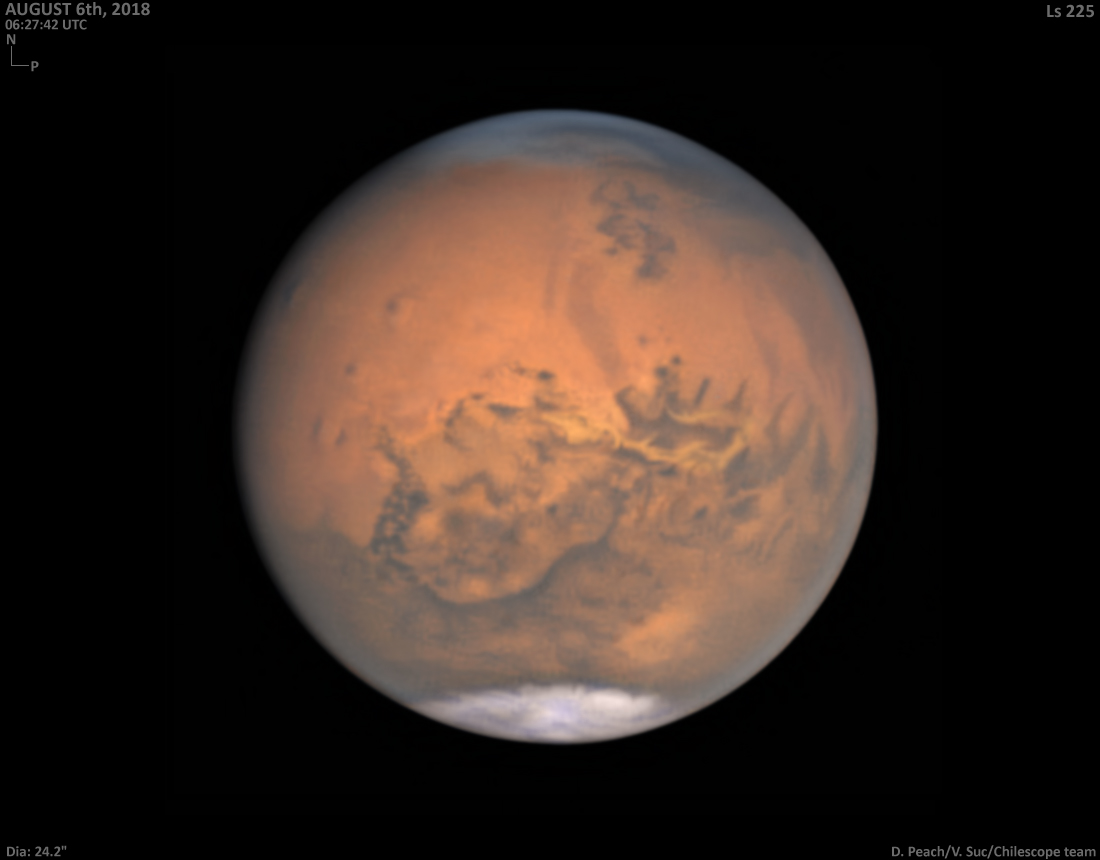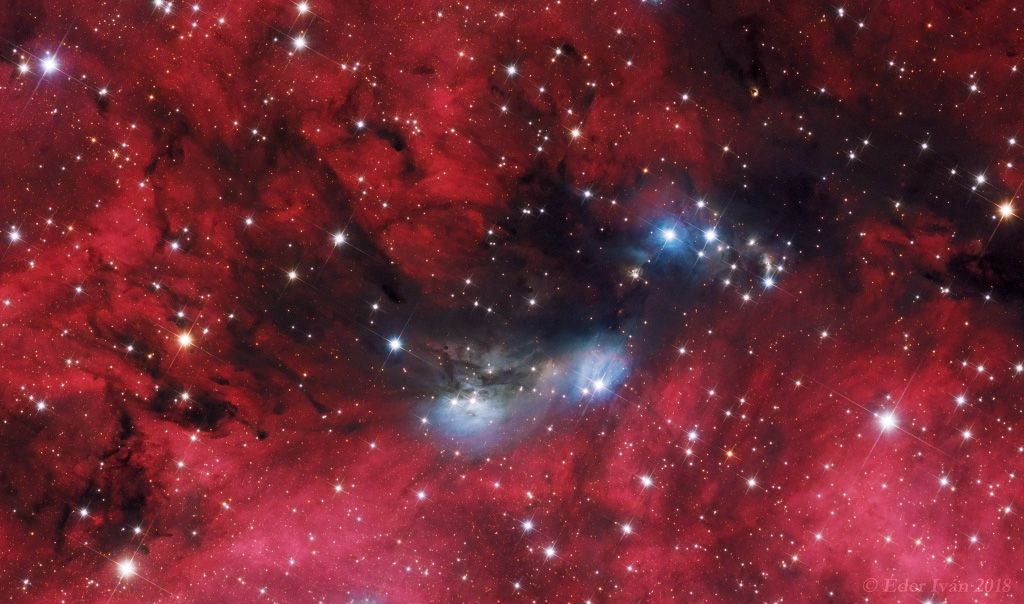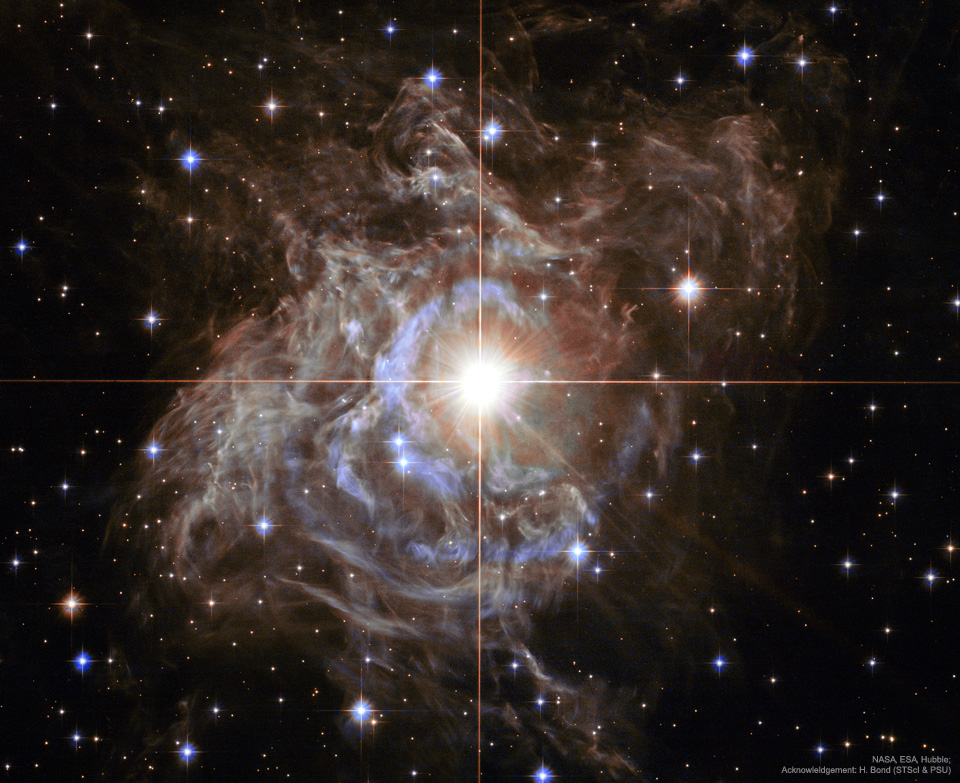| | | After days of negotiations, the U.S. and Canada failed to agree on a deal Friday to update the North American Free Trade Agreement. Talks will resume next week. The U.S. and Mexico reached an agreement earlier. |
| |
|
|
|
| You received this message because you're subscribed to our Breaking News Alerts emails.
| Unsubscribe | Privacy Policy |
NPR
1111 N. CAPITOL ST. NE
WASHINGTON DC 20002 |
| |
| | | | 
Astronomy Picture of the Day Discover the cosmos! Each day a different image or photograph of our fascinating universe is featured, along with a brief explanation written by a professional astronomer. 2018 August 31
 Close Mars
Image Credit & Copyright: D. Peach, V. Suc, Chilescope team Explanation: Still bright in evening skies, Mars was just past opposition and closest to Earth on July 31, a mere 57.6 million kilometers away. Captured only a week later, this remarkable image shows the Red Planet's disk near its maximum size in earthbound telescopes, but still less than 1/74th the apparent diameter of a Full Moon. Broad regional surface shadings are starting to reappear in the tantalizing view as the latest planet-wide dust storm subsides. With the bright south polar cap at the bottom, the Valles Marineris extends along the center of the disk. Just below it lies the roughly circular Solis Lacus region sometimes known as the Eye of Mars. In a line, three prominent dark spots left of center are the volcanic Tharsis Montes. Tomorrow's picture: Aerosol Earth
< | Archive | Submissions | Index | Search | Calendar | RSS | Education | About APOD | Discuss | >
Authors & editors: Robert Nemiroff (MTU) & Jerry Bonnell (UMCP)
NASA Official: Phillip Newman Specific rights apply.
NASA Web Privacy Policy and Important Notices
A service of: ASD at NASA / GSFC
& Michigan Tech. U.
This is an automated email. If you notice any problems, just send me a note at gtracy@gmail.com. You can add and remove email addresses to this distribution list here, https://apodemail.org.Unsubscribe
| | | | | The senator's casket will lie in state in the Capitol rotunda. Congressional leaders and Vice President Pence pay tribute in Friday's memorial service. |
| |
|
|
|
| You received this message because you're subscribed to our Breaking News Alerts emails.
| Unsubscribe | Privacy Policy |
NPR
1111 N. CAPITOL ST. NE
WASHINGTON DC 20002 |
| |
| | | | 
| | | | | Heads of state, record moguls and music legends will honor the Queen of Soul today. Watch Aretha Franklin's funeral here. |
| |
|
|
|
| You received this message because you're subscribed to our Breaking News Alerts emails.
| Unsubscribe | Privacy Policy |
NPR
1111 N. CAPITOL ST. NE
WASHINGTON DC 20002 |
| |
| | | | 
Astronomy Picture of the Day Discover the cosmos! Each day a different image or photograph of our fascinating universe is featured, along with a brief explanation written by a professional astronomer. 2018 August 30
 The NGC 6914 Complex
Image Credit & Copyright: Ivan Eder Explanation: A study in contrasts, this colorful skyscape features stars, dust, and glowing gas in the vicinity of NGC 6914. The complex of reflection nebulae lies some 6,000 light-years away, toward the high-flying northern constellation Cygnus and the plane of our Milky Way Galaxy. Obscuring interstellar dust clouds appear in silhouette while reddish hydrogen emission nebulae, along with the dusty blue reflection nebulae, fill the cosmic canvas. Ultraviolet radiation from the massive, hot, young stars of the extensive Cygnus OB2 association ionize the region's atomic hydrogen gas, producing the characteristic red glow as protons and electrons recombine. Embedded Cygnus OB2 stars also provide the blue starlight strongly reflected by the dust clouds. The nearly 1 degree wide telescopic field of view spans about 100 light-years at the estimated distance of NGC 6914. Tomorrow's picture: pixels in space
< | Archive | Submissions | Index | Search | Calendar | RSS | Education | About APOD | Discuss | >
Authors & editors: Robert Nemiroff (MTU) & Jerry Bonnell (UMCP)
NASA Official: Phillip Newman Specific rights apply.
NASA Web Privacy Policy and Important Notices
A service of: ASD at NASA / GSFC
& Michigan Tech. U.
This is an automated email. If you notice any problems, just send me a note at gtracy@gmail.com. You can add and remove email addresses to this distribution list here, https://apodemail.org.Unsubscribe
Though no single food holds the key to good health or disease prevention, it's not unreasonable to describe several as super. Here's a close look at 16 of them. | | | | | |  Wellness Wire | | Carb Loading: How to Do It Right |  | Filling up on carbohydrates can improve how you feel and perform during exercise. We'll explain the science behind this strategy and how you can do it properly. Read on  | |  Get our Men's Health newsletter Good reads on nutrition, fitness, and the health conditions that affect men most. Subscribe  |  Get our Women's Wellness newsletter Sage advice on exercise, mindful eating, sex, sleep, stress relief, and more. Subscribe  | |
| | |  | | | | To mark the centennial of her father's birth, Jamie Bernstein talks frankly about her new memoir, tracking her life as the daughter of the legendary composer. | | Read this story | | | | | | | | | | | | NPR | 1111 N. Capitol St. NE | Washington, DC 20002 | Privacy Policy
This message was sent to macbud1972.draftpost@blogger.com based on your NPR email subscriptions. If you no longer wish to receive these emails, you may unsubscribe at any time.  | | 
Astronomy Picture of the Day Discover the cosmos! Each day a different image or photograph of our fascinating universe is featured, along with a brief explanation written by a professional astronomer. 2018 August 29
 Nearby Cepheid Variable RS Pup
Image Credit: NASA, ESA, Hubble Heritage Team; Acknowledgement: Howard Bond (STScI & Penn State U.) Explanation: In the center is one of the most important stars on the sky. This is partly because, by coincidence, it is surrounded by a dazzling reflection nebula. Pulsating RS Puppis, the brightest star in the image center, is some ten times more massive than our Sun and on average 15,000 times more luminous. In fact, RS Pup is a Cepheid type variable star, a class of stars whose brightness is used to estimate distances to nearby galaxies as one of the first steps in establishing the cosmic distance scale. As RS Pup pulsates over a period of about 40 days, its regular changes in brightness are also seen along the nebula delayed in time, effectively a light echo. Using measurements of the time delay and angular size of the nebula, the known speed of light allows astronomers to geometrically determine the distance to RS Pup to be 6,500 light-years, with a remarkably small error of plus or minus 90 light-years. An impressive achievement for stellar astronomy, the echo-measured distance also more accurately establishes the true brightness of RS Pup, and by extension other Cepheid stars, improving the knowledge of distances to galaxies beyond the Milky Way. The featured image was taken by the Hubble Space Telescope. Tomorrow's picture: open space
< | Archive | Submissions | Index | Search | Calendar | RSS | Education | About APOD | Discuss | >
Authors & editors: Robert Nemiroff (MTU) & Jerry Bonnell (UMCP)
NASA Official: Phillip Newman Specific rights apply.
NASA Web Privacy Policy and Important Notices
A service of: ASD at NASA / GSFC
& Michigan Tech. U.
This is an automated email. If you notice any problems, just send me a note at gtracy@gmail.com. You can add and remove email addresses to this distribution list here, https://apodemail.org.Unsubscribe
| | | | | White House counsel Don McGahn is resigning this fall after a tumultuous stretch as President Trump's in-house lawyer. He served as Trump's campaign lawyer and championed the president's push to put his mark on the federal bench. |
| |
|
|
|
| You received this message because you're subscribed to our Breaking News Alerts emails.
| Unsubscribe | Privacy Policy |
NPR
1111 N. CAPITOL ST. NE
WASHINGTON DC 20002 |
| |
| | | | 
| | | |


















